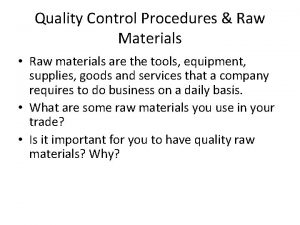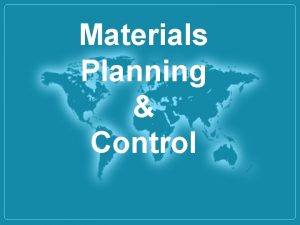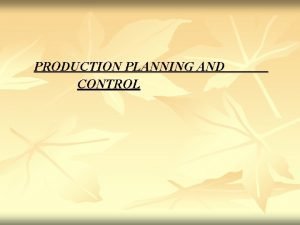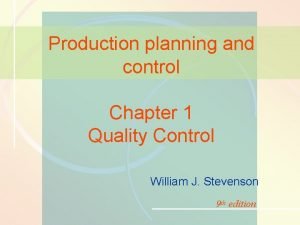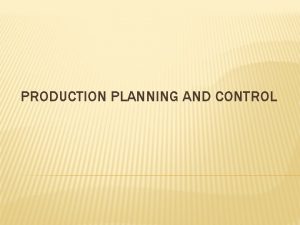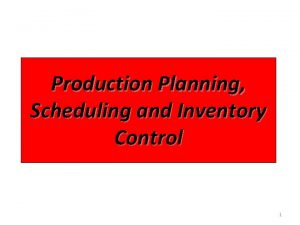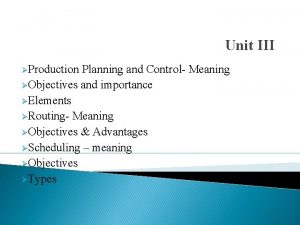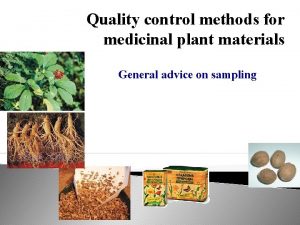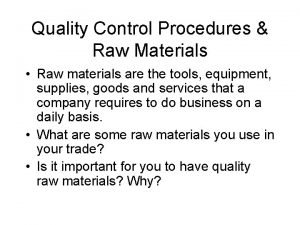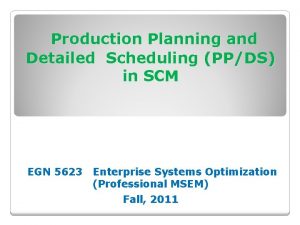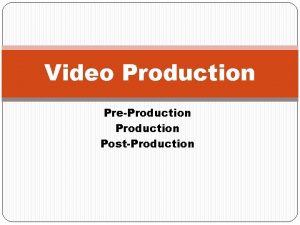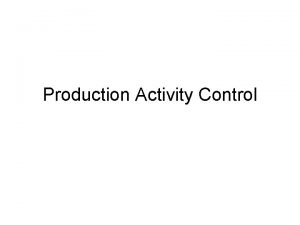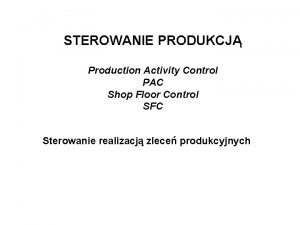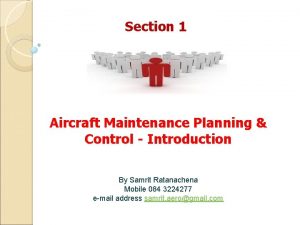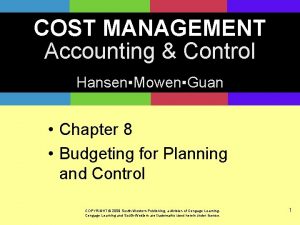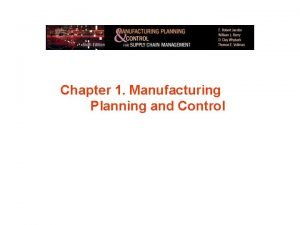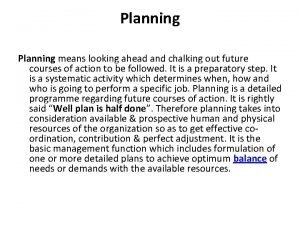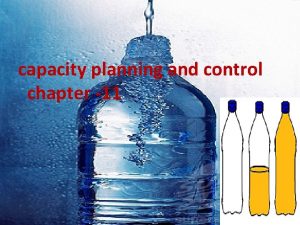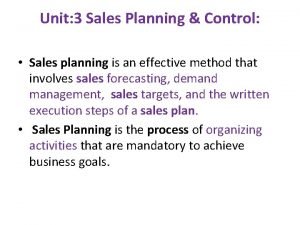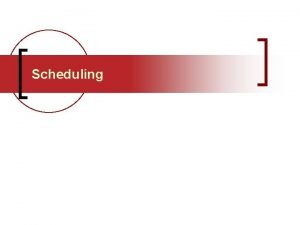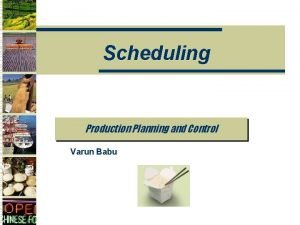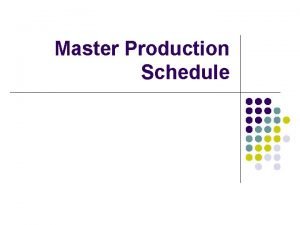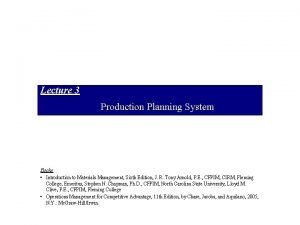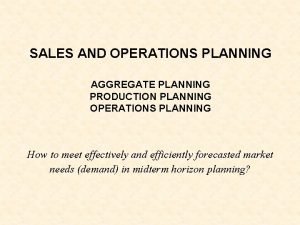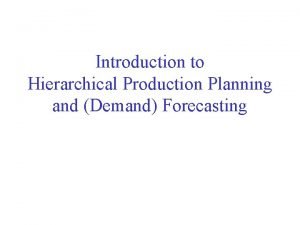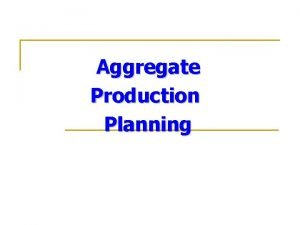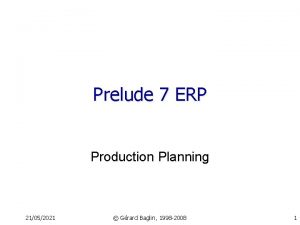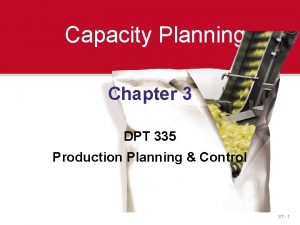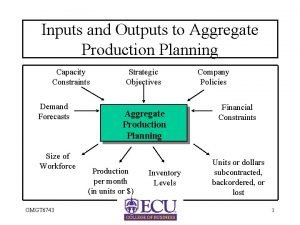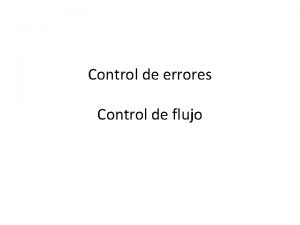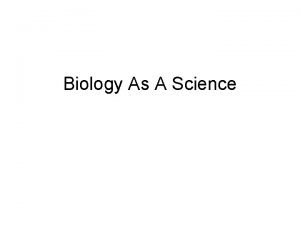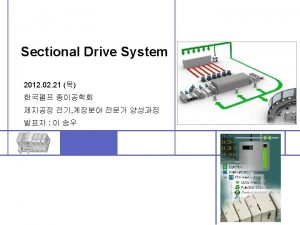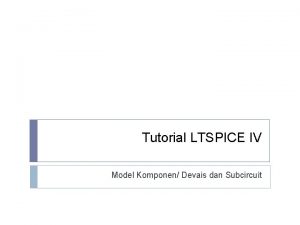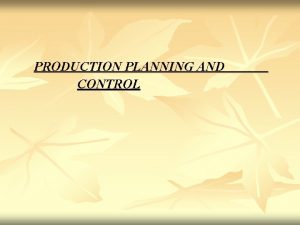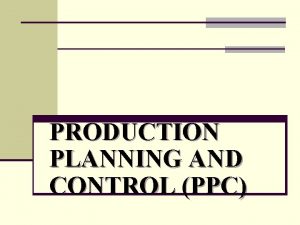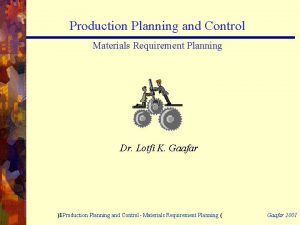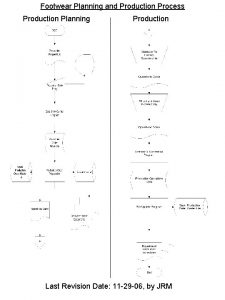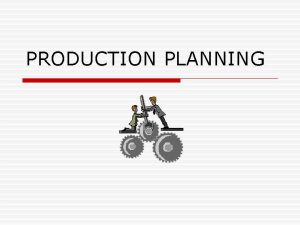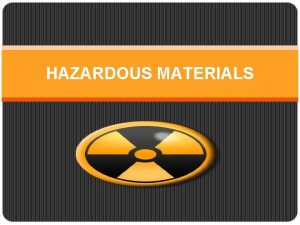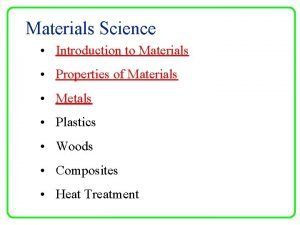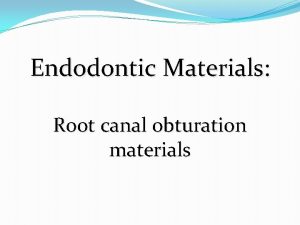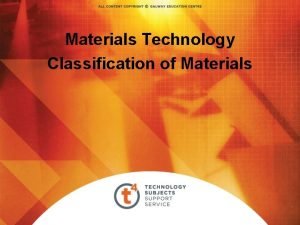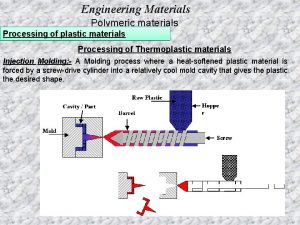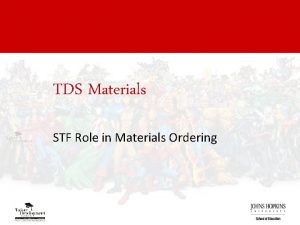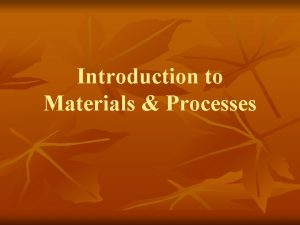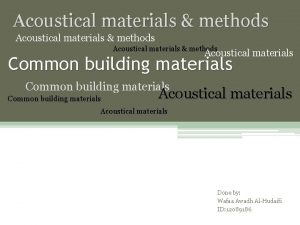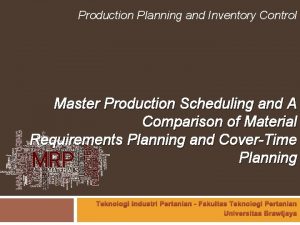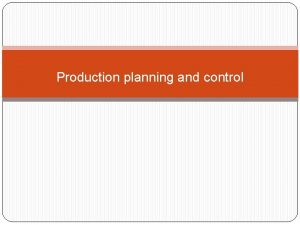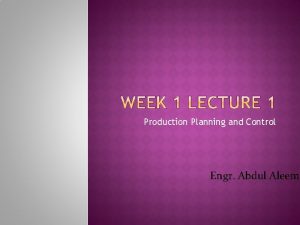PRODUCTION PLANNING AND MATERIALS CONTROL Production planning and


















































- Slides: 50

PRODUCTION PLANNING AND MATERIALS CONTROL

Production planning and Material control

Production planning and Material control Defined as the technique of foreseeing every step in a long series of separate operations, each step to be taken at the right time and in the right place and each operation to be performed in maximum efficiency. � It helps entrepreneur to work out the quantity of material manpower, machine and money requires for producing predetermined level of output in given period of time. Ø

Objective v is the organization of the supply and movement of materials and labor, machines utilization and related activities, in order to bring about the desired manufacturing results in terms of quality, quantity, time and place.

SPREADING ØSpreading is the processes of superimposing lengths of fabric on a spreading table, cutting table or specially designed surface in preparation for the cutting process

Fa bric sprea ding is very im por tantpart of the pro duc tionpro cess be cau seit is basic for obtai ning a high qua lity final pro duct

Requirements of spreading

1. Fabric must be flat 1. During fabric spreading it should be maintained that the fabric is flat. 2. The wrinkle must be removed (by air flow) so that the fabric may be flat.

2. Correct ply tension: � The ply tension of the fabric should be proper. If the tension is low, there will be ridges in the plies and if the tension is too high, the fabric may shrink after cutting and sewing.

3. Alignment of fabric ply: Fabric spreading is done according to length and width of marker. Every ply should comprise at least width of the marker plan. but should have the minimum possible extra outside those measurements 4. Correct ply direction and lay stability: These two factors depend on fabric type, pattern shape and spreading equipment's that are available. When the pattern pieces have been positioned in a particular direction in the marker plan, it is the essential that the fabric is spread according the direction. Symmetrical patterns pieces are placed in the same way up or face to face.

5. Elimination of static electricity: If spreading is done by manmade fabrics, static electricity may generate. It can be eliminated by reducing friction or increasing humidity of the room. Anti-static paper may be used to reduce the static electricity generation. 6. Elimination of fabric flaws: The flaws of fabric must be indicated during spreading and necessary steps to be taken to remove these faults. The general two steps to remove the flaws are : Splicing Over lapping

7. Easy separation of the cut lay into bundles: The size of cut lay into bundles of fabric depends on the height of fabric lays. Some low priced color papers are used in the fabric plies to displace. It helps each bundle to prevent shade variation for displacing. It also helps to catch the slippery fabrics lays during spreading. Generally, the colored papers are rough in surface.

8. Avoidance of fusion of plies during cutting: The heat generated when the fabric lays are cut by using cutting knife due to the friction fabric and knife. Generally, those fabrics are melted due to heat generation to the fabric lays which are made by thermoplastic fibers. To prevent this defect, some anti-fusion papers are used with the gaps of fabric plies during spreading. 9. Avoidance of distortion in spread: The fabric may be creased and folded due to the friction in the bottom of lay by base plate of knife during cutting with straight knife or shifting of fabric lay. As a result, defected pattern may occur. To remove this defect, fabric lay is made on the smooth paper so that, there is less possibility of friction between fabric and table.

10. Matching checks and stripes: For check and stripe fabric, the flaws of fabric must be indicated during spreading and necessary steps should be taken. Marker planning should be done by matching with stripe of check of fabric. Each ply should be correct during spreading on the other for making fabric lay. Then the matching may warp or weft way as required.

Spreading equipment ØSpreading surfaces ( table, pin table, vacuum table) Ø Spreading machines


Manual spreading Ø fabric is drawn from its package which, if it is a roll, may be supported by a frame and carried along the table where the end is secured by weights or by clamps. Ø The operators work back from the end, aligning the edges and ensuring that there is no tension and that there are no wrinkles.

Machine spreading ØSpreading machines carry the piece of fabric from end to end of the spread, dispensing one ply at a time on the spread.

FASTER AUTOMATED MACHINES can spread 100150 yards per minute.

Spreading machines may include: § A motor to drive § A platform on which the operator rides § A ply cutting device with automatic catcher to hold the ends of ply in place § A ply counter § An alignment shifter actuated by photo electric edge guides § A turntable § A direct drive on the fabric support, synchronized with the speed of travel, to reduce or eliminate tension in the fabric being spread.

F A B R I C C U T T I N G

Cutting �Is the production process of separating (sectioning, carving, severing) a spread into garment parts that are the precise size and shape of the pattern pieces on a marker.

Fabric cutting �To cut out the garment pieces from lays of the fabric with the help of cutting templates. �Cutting is irreversible process in garments cutting, so it must be done carefully.

Requirements Of Cutting: Ø Precession of cut Ø Clean edge Ø Consistency in cutting Ø Support of the lay

Three methods of cutting technique: 1. Completely by manual-Hand operated scissors. 2. Manually operated powered knife. §Straight knife. §Band knife. §Round knife. §Die cutter. §Notched cutter. §Drill. 3. Computerized technique. §Knife cutting. §Cutting by water jet. §Leaser cutting. §Plasma torch cutting.

Hand Operated Scissor • Features: Ø First & oldest method of fabric cutting Ø Used for cutting one or two plies of fabric Ø Available to cut the fabric from left to right or right to left Ø Needs more time & contain high cost Ø Used in tailoring & household purpose to cut fabric

Straight Knife • Features: v The elements of straight knife consists of: 1. An electric motor 2. Stand 3. A base plate usually on rollers 4. Handle 5. Knife 6. Knife Guard 7. Wheel v Knife is driven by electric power v Grinding wheel is present to sharp the knife during cutting v Blade edge: straight edge, wave edge, saw edge, serrated edge v Straight edge is mostly used v Blade stroke 2. 5 to 4. 5 cm v Can cut heavy fabric such as canvas & denim

Working Principal: q Two kind of powers are required to operate a Straight Knife v Motor power drive the reciprocating knife v Operator power drives the knife through the lay q The motor power needed is determined by v Height of the lay v Construction of the fabric v Curvature of the line being cut v Stroke of the blade q Greater power of the motor, greater blade movement to cut the fabric

Straight Knife • ADVANTAGE: q Comparatively cheap & transferred easily from one place to another place q Higher lay of fabric can be cut easily q Round corner can be cut more precisely then even round knife q Production speed is very good & fabric can be cut from any angle • DISADVANTAGE: q Some time deflection may occur due to the weight o the motor q Knife deflection is high in risk, when lay height is too high q Sometime accident may happen

Band Knife • Features: q Band knife comprises a series of three or more pulleys, powered by electric motor q Cutting knife is endless in shape & flexible q Blade is usually narrower then on a straight knife q This method m/c is stationary but fabric is moveable q This is like saw mill cutter

Band Knife ADVANTAGE: q. Used when a higher standard of cutting accuracy is required q. Extensively used to cut very sharp corners small parts such as collars & cuff q. Used more in men’s wear than ladies wear q. Intensively risk of accident is low q. Possible to cut 90˚ angle of the fabric DISADVANTAGE: q. Work load is high as m/c is stationary & fabric is moveable q. Not suitable for cutting large amount of garments parts q. Not possible to cut fabric directly q. Fabric wastage is high q. Power loss is high

Round Knife • Features: q. Element of round knife: v. Base plate & Electric motor v. Handle for the cutter to direct the blade v. Rotating circular blade q. Blade diameter varies from 6 -20 cm q. Blade is circular q. Blade is driven by electric power q. Circular knife is driven by 10003500 cm

Round Knife q. ADVANTAGE: q. Suitable for single ply cutting as well as multi-layers (say 20 -30 layers) q. Suitable for small scale cutting q. Suitable gentle curve cutting q. Easy to operate q. Useful for cutting layer parts of a garments DISADVANTAGE: q. Not suitable for cutting very curve lines in higher no. of lays q. Not suitable for higher production q. Possibility of accident is high q. Difficult to cut small component q. Needs skilled operator

• Features: Die Cutting q Mainly two types of die cuttings are available namely: Presses & Clickers q Main parts of all die cutting m/c are Blade, Ram Head, Die, Motor & Operating System of Ram q Die is made by metallic strip q Most useful to cut sharp & small parts

Working Principal: q. Die is prepared with metal strip according to the shape of pattern q. Die press generally has a cutting die just penetrates the cutting pad in order that the fibers of the lowest ply are completely separated q. For die cutting, the spreader spreads a lay to the required placement of dies q. The spread is cut into sections to allow transport to the cutting pad q. The gap between two dies 2 -3 mm are placed when die is taken to cut fabric lay

Die Cutting • Advantage: q Extensively used to cut sharp corners of small parts of dress accurately q Most useful to cut at any shape or any angle q Comparatively less time required q Best method of cutting knitted fabric • Disadvantage: q Fabric loss is high due to the need of block of fabric lay q High labor cost q To change the style quickly is impossible q Difficult to cut large components of dress

Notcher Cutting Features: q. Special type of cutting m/c & used in special case q. Used to cut notch in the edge of some components q. The invention of notcher m/c was done to make notch q. The notch can be made in U-shape or V-shape

Notcher Cutting ADVANTAGE: q. Special type of cutting m/c & used in special case q. Useful to cut small notch to the fabric q. Most useful to make consistency in notching DISADVANTAGE: q. Only used to make notch q. Thermoplastic fiber can not cut by this m/c q. Time loss q. Use of the m/c is limited

Drill Cutting Features: q. Needed to mark on the end of components of dresses especially for pocket & dart setting q. This m/c contains a motor, base plate, drill, & spirit level q. For tightly woven fabric, making of hole by drill is permanent for long q. In hypodermic drill some color is sprayed along with the hole so that it can easy to find the marked place

Drill Cutting ADVANTAGE: q. Needed to mark on the end of components of dresses especially for setting pocket & dart q. Make the hole permanently for long time DISADVANTAGE: q. Only used for making hole in the fabric especially for setting pocket & dart q. For loose woven fabric it can not make the hole permanently for long time

Computer Controlled Knife Cutting Features: q. This method provide the most accurate possible cutting at high speed q. Marker is not necessary to put over the fabric lays during cutting q. Cutting knife is oval shaped & very hard. Sharpness is also high & blade is made of stainless steel q. Cutting knife itself moves according to the direction of computer memory q. This m/c is CAM system m/c & works through CAD system

Computer Controlled Knife Cutting • § § § § • § § ADVANTAGE: Very fast cutting operation Very active cutting by computer controlled system Suitable for very large scale production Speed of can be controlled Intensity of accident is low No need of marker Fabric can be cut 6 -8 times than manual method Less labor cost DISADVANTAGE: Very expensive m/c Higher maintenance cost Skilled manpower is required If correct disc is not loaded in the computer, error will be indicated

Cutting By Laser Beam Features: q. This method, fabric is cut by a ray of light in a very fine spot using a laser q. When the ray falls on a material, it generates heat on the material & cutting is done by vaporization q. Fabric is cut at a speed of 13 meter per min q. Cutting head is controlled by computer

Cutting By Laser Beam • ADVANTAGE: q Very fast cutting operation q Can be cut in a proper line as the cutting head is controlled by computer q As the fabric is cut by ray off high so that no need of sharpening operation • DISADVANTAGE: q Not suitable for cutting of multi-layer of fabric q For thermoplastic fabric the cutting edge should be fused q Very expensive cutting method

Cutting By Water Jet Features: q. This system, thin jet of water is passes through a nozzle in a very momentum q. Pressure of water is 60, 000 pounds per square inch q. Water is worked as like as hard & sharp knife which can easily cut the fabric q. A catcher in the bottom of fabric lays & it used with the same speed & the same direction of water jet

Cutting By Water Jet ADVANTAGE: q. Higher cutting speed q. There is no need of knife to cut fabric so that no need of sharpening operations q. Better to cut hard material DISADVANTAGE: q. Not suitable for higher depth of lay of fabric q. Cutting edge of fabric is wetted by water q. Sometimes water spot should be seen in the fabric q. Need of filtering & deionization of water q. Need of controlling the sound of jet

Cutting By Plasma Torch Features: q. This system, fabric are cut by a thin through the nozzle which is made by Argon gas q. One or more fabric plies can be cut q. Most useful for cutting single ply of fabric q. Fabrics are cut by placing in a table, the surface (85%) of which must be place in a perforated blanked place

Cutting By Plasma Torch • q q q ADVANTAGE: Automatic torch height control system Automatic oxy-fuel gas control system Automatic torch explosion system Pneumatic band clamping Standard auto-nesting package Easily networked • q q DISADVANTAGE: Synthetic fiber not cut Higher number of fabric lay is not cut Need higher skill operator Costly


THANK YOU PO
 Control of raw materials
Control of raw materials Pengertian post production
Pengertian post production Materials planning and control
Materials planning and control What is the meaning of production planning
What is the meaning of production planning Production planning and quality control
Production planning and quality control Difference between route card and route sheet
Difference between route card and route sheet Inventory management and production planning and scheduling
Inventory management and production planning and scheduling Planning controlling
Planning controlling Cant stop the feeling trolls go noodle
Cant stop the feeling trolls go noodle Harmful material
Harmful material Natural materials and man made materials
Natural materials and man made materials Differentiate adopting materials and adapting materials
Differentiate adopting materials and adapting materials Direct materials budget with multiple materials
Direct materials budget with multiple materials Quality control methods for medicinal plant materials
Quality control methods for medicinal plant materials Quality control of raw materials
Quality control of raw materials Location planning management
Location planning management Production planning and detailed scheduling services
Production planning and detailed scheduling services Pre production planning for video film and multimedia
Pre production planning for video film and multimedia Difference between process control and product control
Difference between process control and product control What is positive and negative control
What is positive and negative control Flow and error control
Flow and error control Production activity control
Production activity control Production activity control
Production activity control Production activity control
Production activity control Aircraft maintenance planning and control
Aircraft maintenance planning and control Budget planning and control
Budget planning and control Manufacturing planning and control
Manufacturing planning and control Planning is looking ahead
Planning is looking ahead Long term capacity strategies
Long term capacity strategies Sales budget
Sales budget Sap pp module
Sap pp module Production planning report
Production planning report Master production schedule
Master production schedule Production plan example
Production plan example Sample of production plan
Sample of production plan Hierarchical production planning
Hierarchical production planning Aggregate planning strategies advantages and disadvantages
Aggregate planning strategies advantages and disadvantages Prelude 7 erp
Prelude 7 erp Bakery production planning
Bakery production planning Outputs of aggregate planning
Outputs of aggregate planning Translational research institute on pain in later life
Translational research institute on pain in later life Reynolds transport theorem
Reynolds transport theorem Stock control e flow control
Stock control e flow control Control volume vs control surface
Control volume vs control surface What is negative control
What is negative control Jelaskan tentang error control pada data link control?
Jelaskan tentang error control pada data link control? Control de errores
Control de errores Negative control vs positive control examples
Negative control vs positive control examples Scalar control vs vector control
Scalar control vs vector control Komponen ltspice
Komponen ltspice Inactivism planning
Inactivism planning
